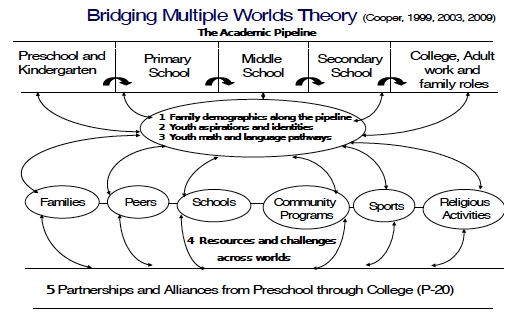Greetings! My name is Catherine Cooper, and I am the Faculty Director of the Educational Partnership Center and Professor of Psychology at the University of California, Santa Cruz. I invite you to explore and use the resources from the Bridging Multiple Worlds Alliance (BMWA).
The BMWA is a growing network of researchers, educators, and policy makers – including evaluators – in the U.S. and other nations who work with P-20 (preschool through graduate school) partnerships to support low-income, immigrant, and ethnic minority youth. These partnerships support youth in building pathways from childhood to college and careers without giving up ties to their families and cultural communities. We work in collaboration with alliance partners, including youth themselves and evaluators of programs and partnerships.
Rad Resource: In the BMWA, we offer three resources that evaluators tell us are especially useful:
- Aligning models and measures to build a common language among partners.
- Tools for research, policies, and practice, including formative and summative evaluation.
- Longitudinal data tools for qualitative and quantitative evaluation and research
The Bridging Multiple Worlds (BMW) Model (shown below) taps five dimensions for opening pathways:
- Demographics—students’ age, gender, national origins, race/ethnicities, languages, and parents’ education and occupation
- Students’ aspirations and identity pathways in college, careers, and cultural domains
- Students’ math and language academic pathways through school
- Resources and challenges across students’ cultural worlds of families, peers, schools, community programs, sports, and religious activities, among others
- Partnerships that reach across nations, ethnicities, social class, and gender to open pathways from preschool through graduate school (P-20)
Rad Resource: Bridging Multiple Worlds Tools include:
- Survey measures of these five dimensions for middle/high school and college students
- Activities for middle and high school students for building pathways to college and careers, with pre- and post-activity surveys (in English and Spanish)
- Logic model template for programs and alliances among programs
- Longitudinal case study templates
Rad Resource: I invite you to join BMWA partners– students, families, schools, community programs, and universities–in using these tools to ask your own questions and build common ground among evaluators, researchers, educators, and policymakers. The tools and other resources are available at www.bridgingworlds.org.
Rad Resource: Bridging Multiple Worlds: Cultures, Identities, and Pathways to College (Cooper, 2011) describes BMW and related models, supporting evidence, tools, and applications in P-20 research, practice, and policy work.
Hot Tip: Healthy partnerships are learning communities where “everyone gets to be smart”. Focus on questions and indicators partners are interested in and display data in clear and meaningful formats. This increases enthusiasm, engagement, and cooperation. Examples of such questions, indicators, and formats are on our website.
Do you have questions, concerns, kudos, or content to extend this aea365 contribution? Please add them in the comments section for this post on theaea365 webpage so that we may enrich our community of practice. Would you like to submit an aea365 Tip? Please send a note of interest toaea365@eval.org . aea365 is sponsored by the American Evaluation Association and provides a Tip-a-Day by and for evaluators.

